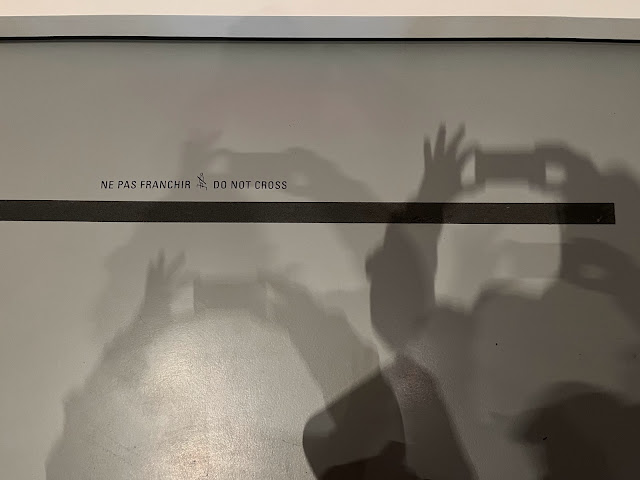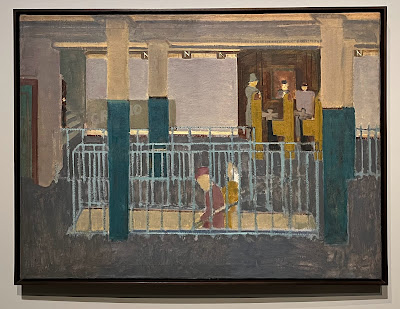Lots of Rothko
Glenn and I went to the Rothko Retrospective today at the Fondation Louis Vuitton. I would not have put Mark Rothko among my top ten favorite artists before the exhibit, and my mind was not changed by it, but I did think it was very interesting and educational. There were paintings from all stages of his career, including figural work from early days--here are three in a series of paintings of the New York Subway, which I like very much...
paintings from a surrealist phase--these did not speak to me, but here was my favorite among them...
and many paintings with blocks of bold color, for which he's most famous.
I do not feel like I have a lot to add to any discourse about his art. In fact, I found it a little impenetrable, the later abstract canvases especially. Normally, when I don't know exactly what to make of a piece of art, I try to examine it very closely and feel that, by doing so, I gain insight into the process and technique, at least. For these pieces, I did not gain a lot through close inspection. (You will notice that all of the photos I include are of entire canvases, no close-up details, which I often like to include.) In fact, I felt that their impact was dulled up close and that they really needed to be viewed from a distance.
I will make one comment about his famous colorblock pieces. I am not an artist, of course, but have often thought that constraints, actual or artist-imposed, physical or conceptual, are what make art interesting. So I found it fascinating that he had imposed these very strict constraints on the nature of his compositions--e.g., must be a large canvas with a background color and blocks of other colors stacked vertically with blurred edges, or something very similar--and yet still managed to create such varied works evoking such far-ranging moods and emotions within those constraints. (The more cynical view is that he had one good, popular idea and was going to drive that into the ground.)
On thing that came out in the exhibition notes was the uneasy relationship between the artist and the admirer/patron, mediated through the work of art itself. Rothko seemed very troubled by the fact that viewers of his art might interpret it in a different way than he had intended, or might see it in proximity to other works of art that did not complement it, or might simply see it in the wrong light or with the wrong wall color behind it. He was famous, in fact, for accepting commissions that he later pulled out of it because the patrons did not appreciate his art in the way he expected them to. I understand how that relationship can be difficult and fraught in the best of circumstances, but Rothko seemed especially poor at navigating it. This prompted a discussion between Glenn and me about what are all of the elements that go into preparation for an exhibit like this. If Rothko were alive, one imagines him hovering over the curator's shoulder, insisting that pieces be shifted one inch lower or to the left, and that the walls be painted a slightly different color, and that different bulbs be put in all of the light fixtures, and that the exhibit only run in the spring months because of the filtered quality of the light coming through a window, and that admission only be given to certain serious people that he had vetted, etc., etc. And we wondered how much a curator would try to recreate what the artist would want or whether they would feel free to make the decisions as they saw fit. (The photo at the top of the post hints at some of the practicalities of putting on such an exhibit. I took it from above at one of the "do not cross" lines in front of a painting, and you can see how layered and complicated the lighting in that gallery was from the shadows my hand threw.)
I will finish up this post with one final photo from the exhibit. I took this in a gallery filled with paintings that were meant for the UNESCO Headquarters in Paris but were never delivered because Rothko pulled out of the commission after some dispute. They were to be hung next to a sculpture by Giacometti at UNESCO, and the exhibition paired them together in this gallery. I thought it was dramatic and beautiful.












When I was in my last year of high school and studying history of art, I tried to force myself to understand and appreciate some abstract art, and was quite successful with Kandinsky and some others (Rothko included). I still appreciate more paintings that 'tell a story', but I can also relish a child-like delight in combinations of color and pattern regularities.
ReplyDeleteVery much agree! There is a lot of abstract art that I love, especially pieces that have interesting color combinations and patterns, as you mention. I just haven't quite come around to a full appreciation of Rothko yet, I think. I'm working on it...
Delete